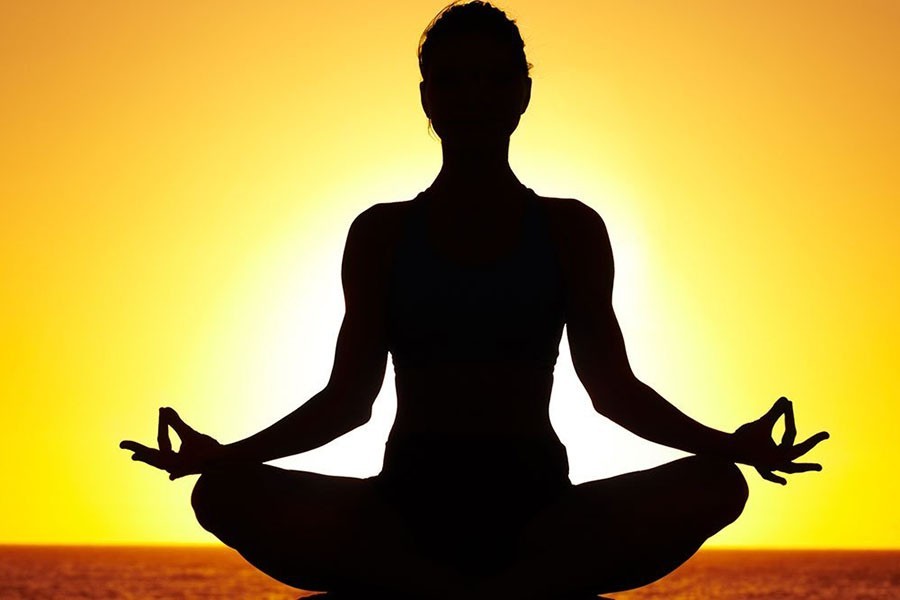
Published :
Updated :

Despite being a calming and popular technique worldwide, the term ‘mediation’ sounds like a hassle. Many people think that the process of mediation is a time-consuming one and needs a well-arranged setup. In reality, it’s not that difficult to do so if one gets a minimum idea and direction towards meditation.
Poet Nayyirah Waheed once said, “If the ocean can calm itself, so can you. We are both saltwater mixed with air.” And meditation is a way to calm ourselves.
In today’s busy world, we are preoccupied with endless activities from dawn to dusk, no matter what our profession or lifestyle is. We make every effort to enhance the external conditions of our lives.
But ultimately, it is the mind that creates our experience of the world and translates this experience into either well-being or suffering. “You mainly feel the way you think”, said American psychologist Albert Ellis. If we can transform how we perceive things, we can transform the quality of our lives. This transformation, training one’s mind, is what meditation is all about. The need for meditation is relevant to any jobholder, business person, or student.
As modern age dwellers, we do not tend to invest much time or energy to ruminate on the causes of our happiness or suffering. We keep thinking what more activities will give us more material gains and therefore our sense of dissatisfaction will fade away. But the truth is, no matter where we are in life, our desire never goes away. The Buddha said in Dhammapada, “As rain breaks through an ill-thatched house, desire will break through an unreflecting mind.”
Not only this dissatisfaction, but our mind is also often filled with other kinds of negative feelings. We spend a lot of time consumed by painful thoughts, plagued by anxiety or anger, licking the wounds we receive from negative criticisms. When we experience these kinds of challenging moments, we wish to manage our emotions and master our minds to be free of these unpleasant emotions. The Buddha also said in Dhammapada, “A disciplined mind brings happiness.”
What’s it?
Meditation is an exercise or training like any other, with its definite purpose. Among several Asian words that translate as ‘meditation’ in English are Bhavana from Sanskrit, which means ‘to cultivate’, and its Tibetan equivalent gom, meaning ‘to become familiar with’. Meditation is a practice that helps us to familiarise ourselves with a clear and accurate way of seeing things and to cultivate positive qualities that remain dormant within us unless we make an effort to draw them out.
Is it scientific?
Throughout the last few decades, many studies have shown that both our physical and mental health is positively affected by meditation. For the last 20 years, intensive studies and its long and short-term effects on the brain have been conducted by major US universities, such as Princeton, Harvard, and the University of California at Berkeley, the University of Wisconsin in Madison as well as research centers in Zurich, Switzerland — all inspired by the activities of the Mind and Life Institute. Not only do they show a highly trained meditator’s brain to be different than non-meditators’, but they also show what wonders it can do to a beginner.
20 minutes of daily practice can contribute significantly to minimise stress, anxiety, anger, and the risk of relapse for people who have previously undergone at least two episodes of depression. Eight weeks of meditation for 30 minutes a day significantly strengthens the immune system, reinforces positive emotions and the faculty of attention, with mitigating risks for patients with high blood pressure.
Ahsan Uddin Ahmed, an assistant professor in the Department of Psychiatry at Shaheed Suhrawardy Medical College in Dhaka said, “If problems related to mental stress like anxiety, insomnia, depression or migraine are in the primary stage, it is possible to fix it. However, if it reaches complex stages, then of course doctor's advice should be taken. But that treatment’s effectiveness can also be increased through the practice of meditation.”
4 easy steps for beginners
Now that we have established why we should meditate, let’s venture into the ‘how.’ These steps follow the book ‘Why Meditate’ by Matthieu Ricard.
Step-1: Finding a suitable place
It is proper to meditate in a quiet place where there is space for the mind to develop clarity and stability.
Step-2: Taking the appropriate physical posture
It is appropriate to take a balanced posture that is neither too tight nor too loose. It is best to keep the legs crossed, shoulders balanced, and spinal column straight.
Step-3: Mindfulness of the breath
Adopting the fore-mentioned posture, one should start breathing calmly and naturally; concentrate all attention on the coming and going of the breath and note the moment when the breath pauses for a moment, between the in-breath and the following out-breath.
Step- 4: Sticking to it
One should try to focus on the breaths continuously over a long period, without falling into distraction.
Meditation is a process of training and transformation. For it to have meaning, it should be reflected in every aspect of one’s life. Even if it is only 20-30 minutes a day, a positive impact is seen. Especially if one practices it at the beginning of the day, it provides an entirely new aroma.
In a subtle but profound way, its effects can change one’s outlook and approach to the things they do. It allows one to experience the events in one’s life with serenity and acceptance. It’s never too late to take some time out of a busy schedule and try to have a journey through the process of meditation.
Sadman Fakid is a BSc student in Chemical Engineering at Bangladesh University of Engineering and Technology.
sadman.fakid69@gmail.com


 For all latest news, follow The Financial Express Google News channel.
For all latest news, follow The Financial Express Google News channel.